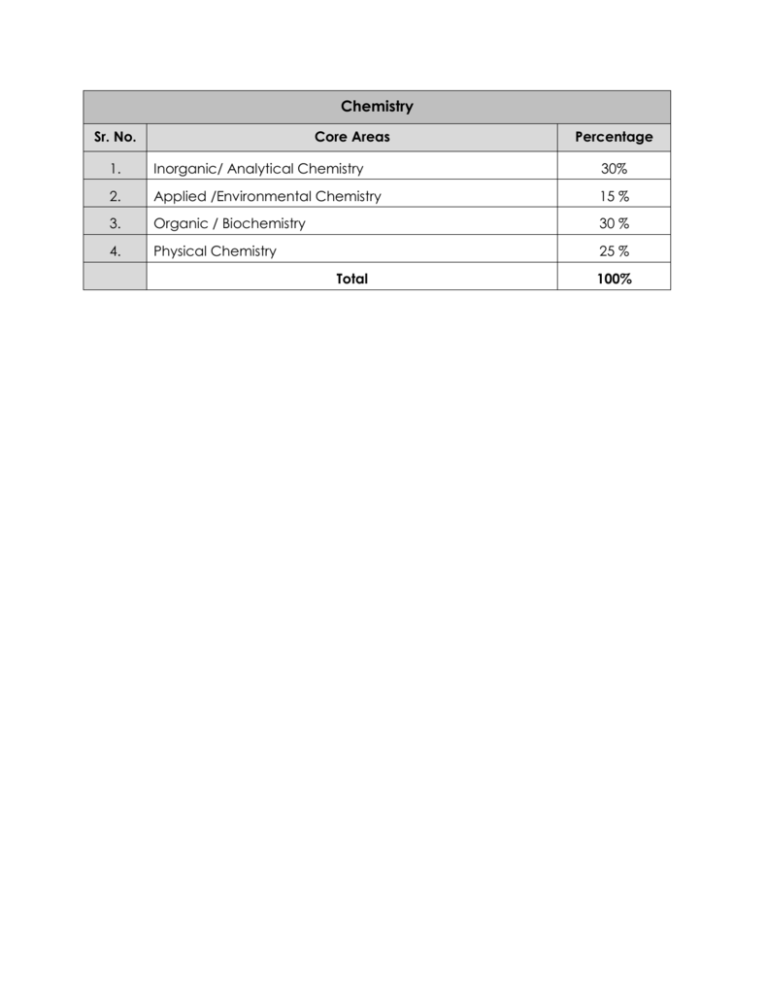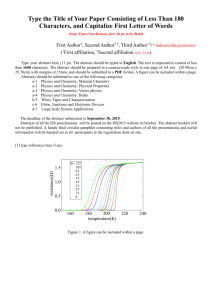Chemistry
advertisement

Chemistry Sr. No. Core Areas Percentage 1. Inorganic/ Analytical Chemistry 30% 2. Applied /Environmental Chemistry 15 % 3. Organic / Biochemistry 30 % 4. Physical Chemistry 25 % Total 100% Chemistry (Detailed) Sr. No. Core Areas Percentage INORGANIC/ ANALYTICAL CHEMISTRY: 1.1 Basics of Analytical Chemistry: 1.1.1 Importance of analytical chemistry. 1.1.2 Analytical Sampling: Analytical data, data handling, statistical treatment of data. 1.1.3 Stoichiometry: Stoichiometric calculations, molar concentrations. 1.1.4 1. Chemical Equilibrium:Law of mass action, degree of dissociations, theoretical principles, acidbaseequilibria, solubility equilibria, complexationequilibria. 1.2 Common Analytical Methods: 1.2.1 Solvent Extraction: Distribution coefficient, distribution ratio, percent extraction, solvent extraction of metal complexes. 1.2.2 Chromatography: Principles and theory, types of chromatography, paper chromatography, thin layer chromatography, column and gas chromatography. 1.2.3 Electrogravimetry: Theory and principles, instrumentation, separation of metal ions, applications. 1.2.4 Voltammetry: Basic principles, Instrumentation and applications. 1.2.5 Conductometry: Basic principles, Instrumentation and applications. 1.3 Spectrometry and Spectrophotometry: 1.3.1 Spectrometry: Basic concepts, classification, theoretical concepts. 1.3.2 UV/visible spectrophotometry: Introduction, LambertBeer Law, deviations, applications. 30% 1.3.3 Molecular Spectrophotometry. 1.3.4 Molecular structure and spectral transitions: Measurement of spectra, light scattering-elastic and inelastic, absorption and emission spectroscopy. 1.3.5 Absorption spectroscopy in UV-Visible region: Absorbance and transmittance, applications and deviations of Beer-Lambert law, spectral resolution and errors in concentration measurements, applications and comparison of fluorescence and phosphorescence spectroscopy, spectral interferences and spectra of mixtures, chemical interferences, instrumental interferences. 1.3.6 Instrumentation: Wavelength separations, sources and detectors for electromagnetic radiations. 1.4 Derivative Spectroscopy: 1.4.1 IR and Raman spectroscopy: Vibrational frequencies, qualitative analysis, IR spectra and Raman spectra, samples for IR and Raman spectroscopy, band intensities and quantitative interpretation i.e., correlation charts and tables, IR and Raman spectrophotometers. 1.5 Atomic Spectroscopy: 1.5.1 Origin of spectral transitions in atoms: Atomic spectra and spectral notations, intensities and line widths of gasphase atomic spectra and its variations with temperature and pressure. 1.5.2 Absorption & emission spectra: Boltzman distribution, spectral line broadening, background correction, factors affecting atomization/ionization. 1.5.3 Atomic absorption and emission methodologies: Optimization of analytical conditions, concentration ranges in atomic spectroscopy. 1.5.4 Interferences: Spectral, physical, chemical and instrumental and their elimination. 1.5.5 Optical components of atomic absorption/emission spectrophotometers: Radiation sources, atomizers, monochromators and detectors, modulation in atomic spectroscopy. 1.5.6 Flame photometry: Flame characteristics and spectral interferences, components of flame photometer, nonmetals and flame photometry. 1.5.7 Sampling: Sample and standard preparation methods for atomic spectroscopy. 1.5.8 Qualitative and quantitative applications of absorption and emission measurements. 1.6 Thermal Methods of Analyses: 1.6.1 General introduction, principles and instrumentation, thermogravimetry, differential thermal analysis and differential scanning calorimetry, evolved gas detection, evolved gas analysis. 1.6.2 Applications: Applications of thermal techniques in analysis of different materials. 1.7 Inorganic Chemistry: 1.7.1 Periodic Table: Periodic classification and periodic Properties of elements. 1.7.2 Theories of chemical bonding: Valence bond theory, VESPR theory and Molecular orbital theory. 1.7.3 Shapes of Inorganic molecules: Electronic attractions and repulsions. 1.7.4 Acids and Bases: pH and pOH, pKa and pKb and their importance and applications. 1.7.5 All theories of acids and bases with examples, i.e., Arrhenius, Bronsted Lowry, Lewis acid and bases, Hard acids and hard bases, Soft acids and soft bases (SHAB). 1.7.6 Chemistry of Interhalogens: examples and explanation, pseudohalogens and poly Halides. 1.7.7 Chemistry of d-block and f-block elements: i. General Properties and applications. ii. Metallic bonding. iii. Crystal field theory: field splitting, the role of strength of legend. iv. Molecular orbital theory. 1.7.8 Coordination chemistry: Preparation and reactions, stability constants, stereochemistry of coordination complexes, nomenclature, Kinetics and mechanism of coordination. Applications of coordination complexes, geometry of coordination compounds. 1.7.9 Lanthanide and Actinides: Occurrence, preparation and chemistry of compounds. 1.8 Chemistry of Non-aqueous Solvents: 1.8.1 General Properties: Classification, types of reactions. 1.8.2 Chemistry of Non-aqueous solvents: NH3, HF, CH3COOH, H2SO4, SO2, Br F3, N2O4 . 1.8.3 Reactions in fused salt systems: effect of temperature. 1.8.4 Rings and cages: clatherates, inorganic rings, chains and cages of B, Si, N, P and S. 1.9 Chemistry of Carbonyl Compounds: 1.9.1 Metal Carbonyls: carbonyl halides, carbonyl chlorides, metal nitrosyls and related compounds. 1.9.2 Organometallic Compounds: Chemistry and bonding of metal sigma and pi complexes, catalysis by organometallic compounds, complexes of molecular nitrogen and oxygen. APPLIED /ENVIRONMENTAL CHEMISTRY: 2.1 Industrial Chemistry: 2.1.1 Material Industries:Glass, ceramics, cement. 2.1.2 2. Chemical Industries: Sulphuric acid, nitric acid, sodium carbonate, fertilizers i.e., urea, ammonium nitrate, phosphate fertilizers, soaps and detergents. 2.1.3 Metallurgical industries: Iron and steel, calcium, copper and aluminium. 2.1.4 Other Important Issues: Percentage yield, selection of raw materials, waste minimization. 15 % 2.2 Environmental Chemistry: 2.2.1 Cycles of matter: carbon cycle, nitrogen cycle, sulphurcycle and phosphorous cycle. 2.2.2 Air pollution:organic air pollution, inorganic air pollution, PCDD’s, PCDF’s, insecticides/pesticides, ozone depletion, acid rain, photochemical smog, Aerosols. 2.2.3 Water pollution. 2.2.4 Soil pollution. 2.2.5 Noise pollution. ORGANIC / BIOCHEMISTRY: 3.1 Organic Chemistry: 3.1.1 Structure and Bonding: Ionic, covalent, coordinate covalent and hydrogen bonds,Sigma (σ-) and pi (π-) bonds. Hybridisation,Inductive effects. hyperconjugation and mesomeric effects .Acidity and basicity . Lewis acids and bases .Basicity and hybridisation .Acidity and aromaticity. 3.1.2 Functional Groups: Functional groups , Alkyl and aryl groups , nomenclature and Drawing organic structures. 3.1.3 Stereochemistry: Isomerism , Conformational isomers,Configurational isomers, Cis- and transisomerism , Optical isomers,Enantiomers,The Cahn– Ingold–Prelog (R and S) nomenclature,The D and L nomenclature ,Diastereoisomers, Diastereoisomers versus enantiomers. 3. 3.1.4 Reactivity and Mechanism: Nucleophiles and electrophiles, Carbocations, carbanions and carbon radicals, General types of reaction ,Polar reactions (involving ionicintermediates),Addition reactions ,Elimination reactions, Substitution reactions, Rearrangement reactions. 3.1.5 Radical reactions, Pericyclic reactions,Reaction thermodynamics and kinetics. 3.1.6 Alkyl Halides:Halogenation of alkanes,alcohols,alkenes. The SN2, SN1 and SNi (substitution, nucleophilic, 30 % bimolecular) reactions.Neighbouring group participation (or anchimeric assistance). 3.1.7 The SN2′ and SN1′ reactions, The E2 (elimination, bimolecular) reaction, The E1 (elimination, unimolecular) reaction ,Substitution versus elimination. 3.1.8 Alkenes and Alkynes :Markovnikov Addition ,antiMarkovnikov addition. Addition of hydrogen halides, bromine and water to alkenes and alkynes.Oxidation by peroxycarboxylic acids (RCO3H) and hydrolysis of epoxides to give anti- dihydroxylation .Reaction of alkenes and alkynes with ozone , carbenes,hydrogen and dienes.Formation of alkynyl anions. 3.1.9 Benzenes: Halogenation, Nitration and Sulfonation. Friedel–Crafts alkylation and acylation. Reactivity of substituted benzenes and benzene rings: activating and deactivating substituents .Orientation of reactions .Ortho-/para-directing activators, Ortho/para-directing deactivators.Meta-directing deactivators.Steric effects versus electronic effects. Nucleophilic aromatic substitution .Reduction of the benzene ring .The synthesis of substituted benzenes .Electrophilic substitution of pyridine pyrrole, furan and thiophene. 3.1.10 Carbonyl Compounds: Aldehydes and Ketones: Nucleophilic addition reactions.Relative reactivity of aldehydes and ketones. 3.1.11 Types of nucleophiles: The Cannizzaroreaction.Nucleophilic addition of carbon nucleophiles: formation of C_C bonds. Reaction with cyanide organometallics and phosphorus ylides: the Wittig reaction. Nucleophilic addition of oxygen nucleophiles: formation of hydrates and acetals. Addition of alcohols: hemiacetal and acetal formation. Nucleophilic addition of sulfur nucleophiles and amine nucleophiles. Formation of imines and enamines.Reactions of imines, oximes and hydrazones. Keto–enoltautomerism.Halogenation of enolates.Alkylation of enolate ions Crossed or mixed aldol reactions. 3.1.12 Carbonyl Compounds: Carboxylic Acids and Derivatives:Structure and Reactivity.Nucleophilic acyl substitution reactions. Relative reactivity of carboxylic acid derivatives .Reactivity of carboxylic acid derivatives versus carboxylic acids .Reactivity of carboxylic acid derivatives versus aldehydes/ketones.Nucleophilic substitution reactions of carboxylic acids. Nucleophilic substitution reactions of acid chlorides, acid anhydrides, esters and amides. Nucleophilic addition reactions of nitriles.Α-Substitution reactions of carboxylic acids Carbonyl–carbonyl condensation reactions .The Claisen condensation reaction IntramolecularClaisen condensations: the Dieckmann reaction. 3.1.13 Aromaticity :Criteria of Aromaticity.The Energy Criterion for Aromaticity .Structural Criteria for Aromaticity .Electronic Criteria for Aromaticity .Relationship among the Energetic, Structural, and Electronic.Aromaticity in Charged Rings.Homoaromaticity.Fused-Ring Systems.Heteroaromatic Systems. 3.1.14 Spectroscopy:Mass spectrometry, Isotope patterns. Determination of molecular Formula. Fragmentation patterns .Chemical ionisation .The electromagnetic spectrum .Ultraviolet spectroscopy Infrared spectroscopy .Nuclear magnetic resonance spectroscopy .1H NMR spectroscopy.Chemical shifts .Spin–spin splitting or coupling. 3.1.15 Synthetic Polymers: Addition polymers.Condensation polymers. Mechanical properties: Tensile strength: Young's modulus of elasticity.Transport properties: Phase behavior: Glass transition temperature.Polymer degradation. 3.2 Biochemistry: 3.2.1 Carbohydrates: Chemistry and structure of monosaccharides.Deoxy sugars. Hemiacetals and hemiketalsMutarotation. Fischer and Haworth projections. Chemistry and structure of Disaccharides: Sucrose, Lactose, Maltose, Trehalose,Turanose and Cellobiose. Mutarotation. Fischer and Haworth projection Trisaccharides: Raffinose ,Melezitose and Maltotriose. Polysaccharide: Glucose/Glucan: Glycogen · Starch (Amylose, Amylopectin) · Cellulose Dextrin/Dextran · Beta-glucan (Zymosan, Lentinan, Sizofiran) Fructose/Fructan: Inulin, Mannose/Mannan NAcetylglucosamine: Chitinhemiacetals orhemiketals (depending on whether they are aldoses or ketoses. Mutarotation Fischer and Haworth projection. 3.2.2 Lipids: Classification of Lipids .Waxes, oils and fats.Triacylglycerol, Glycerophopholipids and sphingomyleins.Steroids: bile acids, cholesterol, ergosterol, vitamin D, estrogens, gastrogens, androgens, adrenocortical hormones. 3.2.3 Amino acids, peptides and proteins: Classification of amino acids.Primary secondary tertiary, quaternary structure, Sequence analysis, C and N-terminal determination. 3.2.4 Enzymology: Structures and mechanisms. Enzyme Specificity. "Lock and key" model.Allostericmodulation.Cofactors and coenzyme. Enzyme Kinetics and Thermodynamics. Enzyme Inhibition. Biological function and Industrial applications. 3.2.5 Nucleic acids:Nucleosides, nucleotides, polynucleotides and Nucleobases. Ribonucleic acids; Mrna, tRNA , rRNA , tmRNA. Deoxyribonucleic acids: Replication, Transcription and Translation. Biotechnology. PHYSICAL CHEMISTRY: 4.1 Gases________________________________________________1% 4.1.1 Behavior of ideal and real gases. 4. 4.1.2 Deviation of gases from ideal behavior. 4.1.3 Virial coefficients. 4.1.4 Van der Waals equation 4.1.5 Transport properties. 25 % 4.1.6 Distribution of energies and speeds; molecular collision and collision theory. 4.1.7 Mixture of gases; the fugacity function. 4.2 Liquids________________________________________________1% 4.2.1 Partialmolal quantities. 4.2.2 Ideal Solutions: Laws of dilute solutions, Henry’s law, Nernst’s distribution law; Raoult’s law; activity and activity coefficients; equilibrium constants; free energy changes in solutions. 4.2.3 Colligative properties: Vapour-pressure lowering, freezing point depression, elevation of boiling point and osmotic pressure. 4.2.4 Phase rule: Phase equilibrium, one component system, multicomponent systems. 4.2.5 Laws of dilute solutions: Henry’s law; Nernst’s distribution law; Raoult’s law; activity and activity coefficients; equilibrium constants; free energy changes in solutions. 4.2.6 Colligative properties: Vapour-pressure lowering, freezing point depression, elevation of boiling point and osmotic pressure. 4.2.7 Phase rule: Phase equilibrium, one component system, multicomponent systems. 4.3 Quantum Mechanics__________________________________3% 4.3.1 Historical background of the development in atomic structure. 4.3.2 Basic concepts of quantum mechanisms; quantum numbers, wave functions; vectors; operators; angular momentum; eigen functions. 4.3.3 Schrodinger’s equation and its application to simple system: particle in one-and-three dimensional box; rigid rotor; hydrogen atom and hydrogen-like ions. 4.3.4 Treatment of many electron atoms: Paulis’ principle; Hund’s rule; spin-orbit interaction. Variation method. Perturbation theory. Molecular symmetry. 4.4 Chemical Kinetics_____________________________________3% 4.4.1 Introduction: Reactions and reaction rate laws, order of reaction, experimental etermination of reaction orders, factors influencing reaction rates, elementary reactions ad reaction mechanism. Reactions with simple kinetic form; 0th-order, 1st-order, 2nd-order, complex reactions. 4.4.2 Transition state theory: Temperature effects; heat capacity of activation; composite rate constants; pressure effects and volume of activation; interpretation of activation parameters. 4.4.3 Reaction mechanisms: Mechanistic interpretation of rate laws, equivalent kinetic expressions, kinetically indistinguishable schemes, pH-rate profiles. 4.4.4 Composite reactions: Reversible 1st and higher order reactions, parallel and concurrent reactions, consecutive first order reactions; steady state approximation; rate controlling step; catalyzed and enzyme catalyzed reactions. 4.4.5 Chain reactions: Decomposition of acetaldehyde; autoxidation of an orange-chromium complex. 4.4.6 Fast reactions: Flow metjods for rapid reactions, shock wave methods, chemical relaxation methods, quenching by florescence method, flash and laser photolysis. 4.5 Chemical Thermodynamics__________________________2% 4.5.1 Introduction: Fundamentals of chemical thermodynamics. 4.5.2 Thermodynamics: Laws of thermodynamics, concepts of enthalpy, entropy, heat capacity, free energy and process reversibility. Applications of thermodynamics to chemical systems. 4.5.3 Entropy as a state function. 4.5.4 Helmholtz Free Energy and the Equation of State. 4.5.5 Gibbs Free Energy. 4.5.6 ClausiusClapeyron Equation. 4.5.7 Statistical calculations of thermodynamic free energy. 4.6 Solid State Chemistry__________________________________2% 4.6.1 Unit cells and crystal systems: Lattices and their description: Bravais lattices; Miller indices; unit cell contents. Point groups and their relevant classification based in symmetry. 4.6.2 Space groups and crystal structures: Close-packed structures (cubic, hexagonal, tetragonal and other packing arrangements). Important structure types (Rutile, Rock Salt, Zinc Blend, Wurtzite. Etc.) 4.6.3 Perfect and imperfect crystals: Types of defects with description. Diffusion of ions in solids; dislocation; mechanical properties and reactivity of solids. 4.6.4 Theories of electrical conductance: Different types of solids, metals and non-metals. 4.7 Solutions______________________________________________1% 4.7.1 General Introduction: Role of solutions in chemistry; classification; concept of solute and solvent; mixtures and their importance. 4.7.2 Interactions in solutions: Solvent-solvent interactions; solute-solvent interactions. 4.7.3 Electrolyte solutions: Ion-ion interactions; ion-pairing, structure of solvates. 6.7.4 Measurement: Microscopic and macroscopic properties: transport properties. 4.8 Colloids and Surfactants_______________________________2% 4.8.1 Capillarity: Surface tension, Young and Laplace and Kelvin equations, orientation at interfaces, thermodynamics of binary systems, the Gibbs adsorption equation. 4.8.2 Surfactants: Nature and classification, miscellization, solubilization, critical micelle concentration, micellarcatalysis. 4.8.3 Emulsion: Emulsion stability, aging and inversion of emulsions, hydrophile-lipophile balance, microemulsions, wetting and contact angle. 4.8.4 Colloidal solutions: Rheology of dispersions, static and dynamic light-scattering, lyophobic and association colloids, forces in colloidal. 4.9 Surface Chemistry_____________________________________2% 4.9.1 Adsorption: Surface and interface; interfacialtension; adsorption forces, thermodynamics of adsorption; porosity; particle size distribution. Physisorption and chemisorptions; adsorption isotherms and their types (Freundlich, Langmuir, BET, etc). Force field in fine pores; microporosity. 4.9.2 Catalysis: Homogeneous and heterogeneous catalysis and gas-solid interface; enzyme catalysis; gas reactions at solid surfaces; diffusion limitations and compensations effect. 4.10 Electrochemistry_____________________________________2% 4.10.1 Basic concepts of electrochemistry: Ideal and non-ideal solutions; electrolyte solutions and types of interactions. Ionic activity; ionic equilibria; types of Electrodes and electrochemical cells. 4.10.2 Theory of electrolytes: Interfacial phenomenon; electrical double layer: Gouy, Stern, Debye-Huckle theory of strong electrolytes. 4.10.3 Electrode kinetics: Difference between controlled potential and controlled current techniques; essentials of heterogeneous kinetics, concept and use of exchange current. 4.10.4 The Nerst Equation and its application. 4.10.5 Solution pH determination by EMF measurements. 4.11 Photochemistry______________________________________1% 4.11.1 Fundamentals: Light and nature of electromagnetic radiations. Electronic structure of atoms; term symbols; absorption and emission of radiations. Interaction of light with atoms molecules. 4.11.2 Laws of photochemistry: Photo excited molecules; monophotonic and multiphotonic processes, photodissociation. 4.11.3 Organic and inorganic photochemistry: Photoelectrochemistry; photochemical reactions in gas phase and in solutions; quantum yield. 4.11.4 Applications: Photographic, photo-polymerization, drugs and pigments, energy conversions. 4.12 Nuclear Chemistry___________________________________2% 4.12.1 Fundamentals: Brief history, transformation hypothesis, electron-proton hypothesis. 4.12.2 Properties of nucleus: Sub-atomic particles; leptons, baryons, mesons, quarks. Nuclear size and density; types of nuclides: isobars, isotones, isomers; mass defect and binding energy. Half-life. 4.12.3 Models of nuclear structure: Nuclear force radii, liquid drop model, shell model. 4.12.4 Equations of decay and growth processes: Successive decay, branched decay; transient and secular equilibrium. 4.12.5 Radioactivity: Types of nuclear reactions: α-decay, -βdecay positron emission, electron capture and their thresholds. Applications of nuclear chemistry. 4.13 Atomic and Molecular Spectroscopy_________________3% 4.13.1 Basic principles and applications. 4.13.2 Rotational levels and Far Infrared Spectra. 4.13.3 Rotational Spectra of Polyatomic molecules. 4.13.4 Microwave Spectroscopy. 4.13.5 Internal rotation. 4.13.6 Vibrational Energy levels. 4.13.7 Rotational Spectra of diatomic molecules. 4.13.8 Infrared Spectra of CO2, HCL, H2O. 4.13.9 Normal modes of vibration. Total 100%






